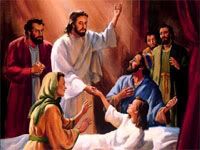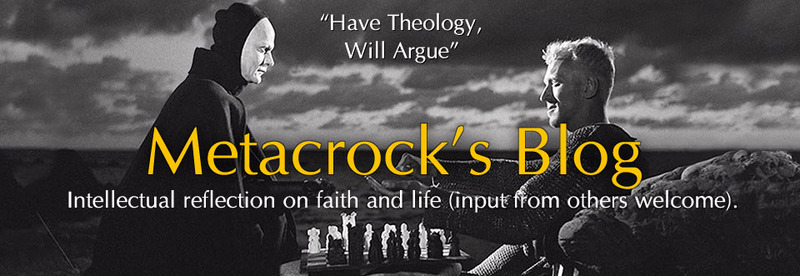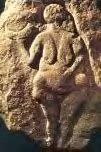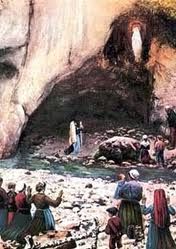
Deep structures
This is actually meant to be a followup to last post on misconceptions
of metaphysics. This is an example of the right use of metaphysics.
That
being has depth is a clue to the meaning of “the ground of being,” or
“being itself.” The depth of being is also related to the notion of the
“power of being.” These are all saying the same thing or very closely
related things. To really understand what Tillich is saying we have to
understand what the depth of being is and relate that to the power of
being. The context of the phrase “depth of being” and the quotation
above about that comes form Tillich’s sermon, converted into a small
book,
The Shaking of the Foundations (op cit).
In
the chapter entitled “the depth of existence,” Tillich tells us that he
is using the term “depth” as a metaphor to indicate an attitude taken
form spiritual experience. Depth symbolizes both special relation and
spiritual quality. Deep implies a profundity (the opposite being
“shallow”) and there is also a sense in which “deep” is used for
suffering (
the depths of despair for example).
[1]
I said above that being having depth means things are not merely as
they appear on the surface, there’s more to reality than just the way
things appear. In
the Shaking of the Foundations Tillich confirms that this is what he had in mind:
All
visible things have a surface. Surface is that side of things which
first appears to us. If we look at it, we know what things
seem to be. Yet if we act according to what things and persons
seem to
be, we are disappointed. Our expectations are frustrated. And so we try
to penetrate below the surfaces in order to learn what things really
are. Why have men always asked for truth? Is it because they have been
disappointed with the surfaces, and have known that the truth which does
not disappoint dwells below the surfaces in the depth? And
therefore, men have dug through one level after another. What seemed
true one day was experienced as superficial the next. When we encounter a
person, we receive an impression. But often if we act accordingly we
are disappointed by his actual behavior. We pierce a deeper level of his
character, and for some time experience less disappointment. But soon
he may do something which is contrary to all our expectations; and we
realize that what we know about him is still superficial. Again we dig
more deeply into his true being.
[2]
Immediately
before the statement about the depth of our being that I quoted above
(en1) he says that depth psychology can help us understand our own
depths but it can’t help us to find the depth and ground of our being.
Immediately after that statement he links the depth of our souls to the
social world, we can know our own souls through the mirror of community
and others.
[3]
This ties us to the heteronomy and the question of the role of spirit
in the creation of culture that was important to Tillich. He then makes
another statement that is remarkably like the one above but this time
focusing upon the social world:
The name of this infinite and inexhaustible ground of history is
God. That is what the word means, and it is that to which the words
Kingdom of God and
Divine Providence point.
And if these words do not have much meaning for you, translate them,
and speak of the depth of history, of the ground and aim of our social
life, and of what you take seriously without reservation in your moral
and political activities. Perhaps you should call this depth
hope, simply
hope. for if you find hope in the ground of history, you are united
with the great prophets who were able to look into the depth of their
times, who tried to escape it, because they could not stand the horror
of their visions, and who yet had the strength to look to an even deeper
level and there to discover hope. Their hope did not make them feel
ashamed. And no hope shall make us ashamed, if we do not find it on the
surface where fools cultivate vain expectations, but rather if we find
it in the depth where those with trembling and contrite hearts receive
the strength of a hope which is truth.
[4]
In
this context he talks about Marxist analysis and social sciences and
understanding of social situations with greater depth than one can gain
from a mere surface perspective. He also grounds that perspective in
first hand experience of social situations rather than just social
sciences alone. Most modern thinkers would have a
hard time seeing what has to do with God or how God could be the ground
of history. But he connects God as the ground of history to the kingdom
of God and providence (see quote above). It seems what he means by
“being has depth” is a structure that permeates all that is. The depth
of being is the unseen structure, the ontology of reality and its
extension into social world through God’s providence. Thus he appears to
actually be saying that God is the ground and end of the natural world
and all that this entails. We can identify “depth” with ontology.
That
being itself indicates the power of being is metaphorical, at the same
time it is part of the concept of the depth of being. Being is not
merely the fact of existence but it also contains the basis upon which
all being is. That would correlate to God as creator. In MacQuarrie’s
terms, “being let’s be.”
[5]
This may imply a more passive role than Tillich had in mind. He views
God’s creative role from the standpoint of a check on nothingness, but
what both are really talking about is an active force of creative power
that brings more being out of being itself.
Being
let’s be is such a passive way to register the idea of “resisting”
nothingness, but at the same time both are means of avoiding the direct
statement, “God is the creator of all that is.” Nevertheless that’s
obviously what they are saying, or trying not to say. Obviously, then
Being is necessary and “the beings” (in McQuarrie speak) are
contingencies. Being itself is necessary being, the beings are
contingent being. This is another aspect of the depth of being. It’s not
just so simple that all we need to do is to rattle off a list of
concrete things we can observe in the world. There are two levels,
necessity and contingency, or two modes of being. Within each role there
are different roles. On the level of necessity being is eternal, on the
level of contingency being is temporal. Tillich makes much of this
distinction. The difference in the two and the sense of the numinous it
evokes are very important for Tillich and will figure prominently in the
arguments that can be made in terms of reasons to believe.
The
reason Tillich takes such a backwards way of expressing God’s creative
force is to emphasize the distinction between being and nothingness.
This is the primary first and original distinction in reality, the
bottom line so to speak between something and nothing. The first
distinction in existence is that between being and nothingness. The
power of being to resist nothingness (God’s creative force) is the first
basis upon which anything is at all. That means we can look at this
creative force as the nature of being the basic bottom line of what it
means to be and what being is. Thus if we choose for some reason to call
this force “God” if we want to use that term, which Tillich says in the
quotation above is the meaning of that term, we can say that God is
“being itself.” God is this basic force that is the first indentation in
all of reality. It is both first temporally (it would be the basis of
time) it would be “fist” ontologically. Tillch is thinking in a way that
modern scientifically ensorcelled people are not really able to think,
and have never thought. McQuarrie puts it into a passive sense “let’s
be,” for a different reason. He warns of Heidegger’s tendency to
“stretch language” or the awareness of Heidegger (and himself) that to
speak of being at an ontological level is a stretch beyond the confines
of fact based conceptualism. For him being’s role
is the fomentation of more being, or “the beings” is expressed in a
passive sense to remove the emphasis upon the activity of a creative
agent.
Tillich’s ontology as illustration of depth in being
Another
aspect of the depth of being is the diversity of being. Tillich
develops many themes of meaning, diversity, and historicity in laying
out the Gospel framework and translating it into his phenomenological
take on the diversity of being. Human being, fallen nature, sin,
redemption, new being in Christ, these are standard Christian themes but
a good deal of his
Systematic Theology is devoted to exploring
them from the perspective of their relationship to being. What he’s
doing there is demonstrating the depth of being ontologically and in
terms of human experience (vol II of
Systematic Theology). Volume I of that work is about “Being and God.” Here he deals with topics of “The Question of Being: Man, Self and World.”
“God is the answer to the question implied in being” he says.
[6] He
first deals with reason and revelation. Then he moves into the question
of being and its meaning. He says that in coming to terms with reason
and its take on existential conflicts, one is forced into asking the
most essential question of all,
why is there something rather than nothing at all? But I have given this in Heidegger’s terms. Tillich puts it a bit differently “why is there something, why not nothing?”
[7]
He points out that to ask “why is there not nothing?” is to attribute a
kind of being to nothingness. Thus as he puts it “one cannot go behind
being.” What he’s saying is, like trying to imagine one’s own non
existence, it can’t be done. We cannot get under being itself, its’ the
furthest we can go back in our understanding, and it eludes our
understanding. Thought is based upon being and it can’t go beyond its
base. One can imagine the negotiation of things, however, and it can
“describe the nature and structure of everything that is the power of
resisting non being.”
[8] Ontological
questions, he points out, are not tautologies because of this ability
to mentally play with being and non being. We are not merely saying
“being is being” when we try to define what it is, because there’s a
possibility of negating any particular form of being. The possibility of
universality and less than universal aspect of forms of being make
ontology possible. There are concepts which are less universal than
being but more universal than any concept about being, thus these are
“categories” of thought.
/...These
categories form the basis of theological significance. These are
central concepts that make theology “go,” so to speak (not Tillich’s
phrase). These are ontological concepts, ontology is not theology. One
can be an atheist and totally secular and do ontology as part of
philosophy, and such a thinker would have to deal with these concepts.
But in like manner all theologians must deal with them as well. While
they are not theology per se they are essential to theology. The
concepts are: (1) the structure implicit in the basic ontological
question (why is there something rather than nothing?); (2) the elements
which constitute ontological structure; (3) characteristics of being
which are the conditions of existence; (4) categories of being and
knowing.
[9]
The structure (1) is that the question presupposes an asking subject,
and an object being asked about. This is the subject/object structure
that is presupposed and that in turn assumes the structure of world and
self; this as the basic articulation of being. That the self has a world
to which it belongs and from which it will deduce the nature of its
being precedes all other structures and will be the basic analysis which
precedes all other analysis.
[10]
The elements of the ontological structure he groups into three sets of
pairs: individuality and universality, dynamics and form, and freedom
and density. These are polarities and the first expresses self
referential nature of being.
The
ontological concepts pertaining to number (3) (characteristics of
being) “expresses the power of being to exist,” in Tillich’s own words,
“and the difference between essential and existential being.”
[11] There
is a duality for Tillich between essential and existential thinking.
One is inherent in the other, as existentialism is meaningless without
an essentialism to play off it. No ontology can disregard these two
aspects.
[12]
Existentialism is a revolt against the predominance of essentialism.
Essentialism came to be identified in theology with “stasis” and
existents with movement, or process theology. Tillich saw
a
unity between the two, one assuming the other. Tillich says
essentialism is related to universalism, and we can’t deal with concepts
in the world without universals. Thus existentialism has to assume
essentialism and the two have to work together.
[13]
The fourth level deals with the categories of thought or the basic
concepts. These he calls “structures of finite being and thinking.” I
suppose the Kantian categories would be placed here. “If time and space
are called ‘categories’ this is a derivation from the Kantian
terminology which calls time and space forms of intuition. But the
larger sense of category has been accepted generally, even in post
Kantian schools.”
[14]
Tillich says that determining the exact nature and number of these
categories is the on going and never ending task of philosophy.
[15]
He isolates four such categories: time, space, causality, and
substance. These are categories that have the most theological
importance. Quantity and Quality he says have less theological
importance. He discusses other categories and their relation to the four
points above, but I will forgo that as it really doesn’t have a direct
bearing on the task before us here. He does focus on finitude at this
point (p165) as having a major bearing on the ontological question of
God.
....He’s going to argue that ontological concepts are
a priori. What he means by
a priori is not quite the same as most logicians understand it. We think of
a prori
as a tautological statement, a statement where we only need to know the
meaning of the terms in order to understand the truth of the statement.
Tillich makes it sound like the thinks
a prori means empirical
data. He says it’s ultimately a matter of experience. I don’t think he’s
confusing it with empirical data. He is saying that the ultimate
understanding of what terms mean is a matter of experience. In other
words we think of
a prori as statements like “all husbands are
married men.” If we know what a husband is we know all of them are
married men. Tillich is saying that the idea of husbands and marriage is
not some eternal truth in a vacuum. We only have a concept of those
terms because we live in a culture that has a convention of marriage.
Thus in an ultimate sense the
a priori concepts originate form
the experience of a life world in which cultural constructs have a
shared meaning. The concepts of Being, the categories, are
a priori
but in the same way rooted in our experience of being. As Tillich says
“they constitute the very structure of experience itself.”
[16] IF experience changes a new
a priori
will from. Tillich discusses process theology and the question of a
static understanding of God. He identifies with a tradition from Scotus
to Heidegger, picking up Bergson along the way, and moving toward
indeterminacy in the ground of being. But it dose not remove
a prori structure from ontology or Being.
[17]
Still
setting up the discussion of finitude and being, he moves to the
prelude to that discussion, the self-world relationship. Every being
participates in the structure of being, but man alone (in so far as we
know) is aware of it. We are the only being we know that has alienation
and estrangement. We can describe behavior but we do not know what the
behavior means to others. We are the only being we know of that asks the
ontological question (why is there something rather than nothing?) and
the only one that can try to answer it. In Heideggerian terms, as
Tillich puts it, we are only able to answer because we understand the
nature of “being there.” Or Tillich speak, we experience “directly and
immediately the structure of being and its elements. As stated above the
ontological structure is the structure of the ontological question, the
assumption and self and world, and that’s what we are moving to as a
prelude of discussion of finitude.
Then there is
also no 2 from above the structure of being grouped into three sets of
pairs: individuality and universality, dynamics and form, and freedom
and density. These are polarities and the first expresses self
referential nature of being. These are
a prori concepts. Self and
world is a basic part of this structure. Humanity is not merely a
passive object of study, but a living consciousness in the process of
learning and apprehending these structures first hand.
Humanity
cannot be turned into an object of study under the guise of making
understanding easier. We are the student as well as the object, so to
reduce humanity itself to an object is lose the phenomena of what it
means to experience being the object or being thing studied. We can’t
step outside of that experience and study it as an object
dispassionately without changing our understanding of what that thing is
we would study.
[18] This leads into what Tillich discusses in
The Courage To Be where speaks of the courage to be a part of and the courage to be apart from.
[19]
As the ontological question implies humanity understands itself as having selves that live in a world. This is the organically
a priori
set up of asking the question. The relationship between self and world
is dialectical, we must be a part of, and we must be apart from. To
study, to understand to live, to know, to remain true to what we
understand we must go play this game of tag, now standing alone as apart
from the world, now standing with the world as part of it. There is no
question of the existence of the self, according to Tillich. The
Postmodernists made a big deal out of the idea there is no core self.
That is a somewhat different question, however, depending upon what is
meant by “core,” but there is clearly some form of self since someone
had to write those articles, and since even making the argument “there
is no self” would require that one be a self and understand something
about the concept. According to Tillich the question is self awareness
of self relatedness.
[20] This
is a dialectical relationship in another way as well, in that the
relationship of self and world is part of the larger dialectic of being
and nothingness, because it is part of the depth of being and part of
the basic categories that emerge from ontological structure. So the
importance of this is going to be that in the discussion of finitude the
apprehension of our own finitude and what we make of that vis a vi
Being itself and it meaning in terms of the object of ultimate concern
is hinged upon self understanding, and understanding of self in relation
to the world as a crucial aspect of the depth of being; thus this will
figure into understanding being itself as indicative of the object of
ultimate concern. As shall be seen the object of ultimate concern is
indicative of the divine aspect of Being itself, or “holy being.”
The self world polarity is the basis of the subject/object structure of reason, according to Tillich.
[21]
The world is seen as a structured whole, as such it is called
“objective” because the many self-world relationships in being all
relate more or less the same basic idea of a world. The self is a
structure of “centeredness” in terms of awareness, for this reason it is
termed “subjective.” In other words subjective refers to the center of
awareness which takes in the sense data and relates itself to that which
is beyond itself, the world. Objective refers to the single “outside”
nature of that which is shared in this awareness by the many selves.
Reason is actually makes these, that is it makes the self a “self” and
the world a “world.” This is because it is through our constructs of
reason that we attach meaning to these terms and understand them in
relation to each other, which is a function of their structured
relationship. Without the structuring aspect of reason being would be
chaos. “Where there is reason there is a self and a world in
interdependence.”
[22] In
cognitive terms anything toward which the cognition is directed is
considered an object, be it God, or individual items in nature,
attitudes, or ideas. We cannot resist making God an object for this very
reason. If we think about the concept of God we make God an object.
This holds a danger, however, in that we tend to objectify that which we
hold in this act of cognition. “If God is brought into the
subject-object structure of being he ceases to be the ground of being
and becomes one being among others (first of all a being beside the
subject who looks at him as an object). He ceases to be the God who is
really God. “
[23]
Various theologies try to escape this problem in various ways. The
prophetic tradition insists that we cannot see God; sight is the most
objectifying aspect of cognition. Knowledge of God is reveled and
understood through man, thus even when God becomes the object God
remains the subject (this is just how Tillich puts it).
[24]
Mysticism attempts to overcome the problem by ecstatic union. In
whatever way the resolution is achieved it must be to acknowledge that
no language of God can make God an object. Thus language about God must
be either negative, or analogical.
There
is another sense in which something is made into an object, according
to Tillich, that is in robbing it of all of its subjective elements.
That is, to turn something into a “thing.” We resist calling human
beings “things” because our subjective qualities lead us to disvalue
mere things as inhuman, and to value humanity because of its subjective
elements.
[25]
One of Tillich’s major concerns is that God not be treated as a
“thing.” For those who believe that Tillich is reducing God to the level
of an impersonal force or mere abstraction this is another rebuff. But
atheists reduce God to the level of a thing, and turn God into another
thing in creation alongside all the many things we see in the world.
This has nothing to do with personality but it does mean God can’t be
conceived as just an impersonal force or a mere abstraction without
defeating Tillich’s purpose. He does not include this argument, but it
seems rather clear from what he says. The reductionistic atheist reduces
all things to the level of “a thing” devoid of subjective elements.
Atheists greatly fear subjectivity. That’s always the bottom line in all
of their refutations of God arguments, “that’s subjective.” The
reductionist view-point treats all sense data as “information” and
information is a collection of things, which can be homogenized and
abstracted into “data” and “reduced” to it’s most basic level which of
course would lose any subjective elements as it loses the phenomena that
makes the aspect that which requires reducing to fit into the atheist
world view. The reductionist sees human perceptive powers and thought as
side effects of chemicals and brain function that makes thought “mere
subjectivity” and that is among the phenomena to be lost in explaining
human consciousness. To reduce humanity to “a thing” one must reduce
human consciousness to a mere epiphenomenon. Parmenides saw the basic
ontological structure as the unity of being and the word (
logos)
in which it is grasped. Thus from this Tillich draws the observation
that subjectivity is not an epiphenomena but a primary phenomena
although related in polar opposite to objectivity.
[26]
One cannot derive subjectivity from objectivity or vice versa. The
attempt to do so has meant either the subjugation of humanity to numbers
and to machines, or the romantic rebellion and undisclosed abandon
which sacrifice reason. Tillich asserts that the basic ontological
structure cannot be derived. The relation is one of polarity. “What
precedes the duality of self and world, of subject and object,” he asks?
His answer is that this is a question in which “reason looks into its
own abyss—an abyss in which distinction and derivation disappear, only
revelation can answer this question.”
[27]
[13] Tillich,
History…, op cit, 541.
[19] Tillich,
Courage…, op cit, find
[25] Tillich,
System I, 173






